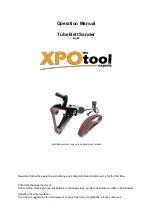
SKU 93867
For technical questions, please call 1-800-444-3353
Page 3
machines.
9.
Maintain tools with care
. Keep tools clean and in good condition for better and safer performance.
Follow instructions for lubricating and changing accessories. Inspect tool fittings and hoses periodically
and, if damaged, have them repaired by an authorized technician. The handles must be kept clean,
dry, and free from oil and grease at all times.
10.
Stay alert. Watch what you are doing, and use common sense when operating a air tool. Do
not use a air tool while tired or under the influence of drugs, alcohol, or medication.
A moment
of inattention while operating air tools may result in serious personal injury.
11.
Avoid accidental starting.
Be sure the Throttle Lever is in the OFF position before attaching the
air pressure hose.
Carrying air tools with your hand on the throttle lever invites accidents.
12.
Remove adjusting keys or wrenches before connecting the tool to its air supply.
A wrench or a
key that is left attached to a rotating part of the air tool may result in personal injury.
13.
Do not overreach. Keep proper footing and balance at all times.
Proper footing and balance
enables better control of the air tool in unexpected situations.
14.
Use clamps (not included) or other practical ways to secure and support the work piece to a
stable platform.
Holding the work by hand or against your body is unstable and may lead to loss of
control.
15.
Do not use the air tool if the throttle lever does not turn it on or off.
Any tool that cannot be controlled
with the throttle lever is dangerous and must be replaced.
16.
Disconnect the air hose from the tool before making any adjustments, changing accessories,
or storing the tool.
Such preventive safety measures reduce the risk of starting the tool accidentally.
17.
Check for misalignment or binding of moving parts, breakage of parts, and any other condition
that may affect the tool’s operation. If damaged, have the tool serviced before using.
Many
accidents are caused by poorly maintained tools.
18.
Tool service must be performed only by qualified repair personnel.
Service or maintenance
performed by unqualified personnel could result in a risk of injury.
19.
When servicing a tool, use only identical replacement parts.
Use of unauthorized parts or failure
to follow maintenance instructions may create a risk of electric shock or injury.
20.
Maintain labels and nameplates on the tool.
These carry important information. If unreadable or
missing, contact Harbor Freight Tools for a replacement.
21.
When starting a handheld air tool, always maintain a firm grip on the tool to resist starting torque.
22.
Always keep the air pressure hose away from moving parts on the tool.
23.
Hold tool by insulated gripping surfaces when performing an operation where the tool may
contact hidden wiring. Contact with a “live” wire will make exposed metal parts of the tool “live”
and shock the operator.
24.
Never lay the tool down until the motor has come to a complete stop.
The tool may create
unforeseen risk while the motor cycles down.
25.
WARNING!
Some dust created by power sanding, sawing, grinding, drilling, and other construction
activities, contain chemicals known (to the State of California) to cause cancer, birth defects or other
reproductive harm. Some examples of these chemicals are: lead from lead-based paints, crystalline
silica from bricks and cement or other masonry products, arsenic and chromium from chemically treated
lumber. Your risk from these exposures varies, depending on how often you do this type of work. To


























